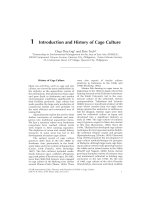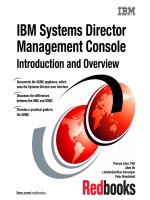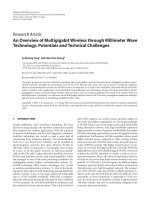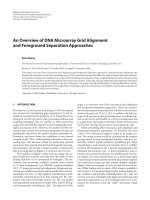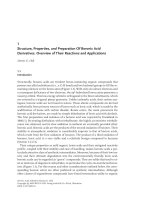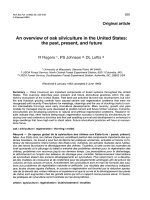Introduction and overview of KFC Corporation
Bạn đang xem bản rút gọn của tài liệu. Xem và tải ngay bản đầy đủ của tài liệu tại đây (184.77 KB, 27 trang )
Outline:
I. Introduction and overview of KFC Corporation
II. Body
1. Environment factors effect to international strategies of KFC
1.1. National environment
1.1.1. Home country: America
1.1.2. Host countries
1.1.2.1. Vietnam
1.1.2.2. Australia
2. International environment factors
1.2.1. The political environment
1.2.2. The economic environment
1.2.3. The social cultural environment
1.2.4. The demographic environment
1.2.5. The technological environment
2. How does KFC segment the market
2.1. In America
2.2. In Vietnam
2.3. In Australia
3. Best activities that KFC used in Vietnam
III. Conclusion
Group members:
1. Phan Thi Thanh Binh ( group leader)
2. Le Thi Quynh Anh
3. Tu Thi Lan Anh
4. Hoang Thi Tuyet Anh
5. Le Thi Ngoc Anh
6. Nguyen Thi Anh
7. Mai Thi Chi
8. Nguyen Hong Chi
9. Do Thi Chinh
10. Nguyen Thi Cham
I. The introduction and overview of Kentucky Fried Chicken
1.1. Introduction
International marketing (IM) or global marketing refers to marketing carried out by companies
overseas or across national borderlines. This strategy uses an extension of the techniques used in
the home country of a firm. It refers to the firm-level marketing practices across the border
including market identification and targeting, entry mode selection, marketing mix, and strategic
decisions to compete in international markets.
A international company must have a good international marketing strategy. To be successful
in home country environment and host country environment, international businesses need use
several factors in the environment to gauge the direction in which they should steer. There are
various environmental factors which can impact the businesses in an economy. These
environmental factors can be categorized into external and internal environment of the businesses.
The internal environment of the company includes the factors which are within the company and
under the control of company like product Organizational culture, Leadership, and Manufacturing
(quality). On the other hand, the external factors are not under the control of the company and
include Social environment, political conditions, suppliers, competitors of the company,
Government regulations and policies, accounting agencies like Accounting standard board,
Resources in an economy and demographics of people.
From that, we can see environmental factors have much effects to international marketing
strategy of an international company. And here is the case of KFC - the world's most popular
chicken restaurant chain. It is not only successful in American, but also in many other countries
over the world. To do this, KFC always evaluates the environmental factors and often find ways to
succeed through innovative technologies, clever marketing tactics and unique product and service
offerings. So, what are those environmental factors? How does KFC segment the market? What is
the best activity KFC used in Vietnam? Let’s find the answer for these questions in the details
below.
1.2. Overview of KFC
KFC, founded and also known as Kentucky Fried Chicken, is a chain of fast food restaurants
based in Louisville, Kentucky, in the United States. KFC has been a brand and operating segment,
termed a concept of Yum! Brands since 1997 when that company was spun off from PepsiCo as
Tricon Global Restaurants Inc.
KFC Corporation, based in Louisville, Kentucky, is the world's most popular chicken
restaurant chain, specializing in Original Recipe, Extra Crispy, Kentucky Grilled Chicken and
Original Recipe Strips with home-style sides, Honey BBQ Wings, and freshly made chicken
sandwiches. While its primary focus is fried chicken, KFC also offers a line of grilled and roasted
chicken products, side dishes and desserts. Outside the USA, KFC offers beef based products such
as hamburgers or kebabs, poutine, pork based products such as ribs and other regional fare.
The company was founded as Kentucky Fried Chicken by Colonel Harland Sanders in 1952,
though the idea of KFC's fried chicken actually goes back to 1930. Although Sanders died in 1980,
he remains an important part of the company's branding and advertisements, and "Colonel
Sanders" or "The Colonel" is a metonym for the company itself. The company adopted KFC, an
abbreviated form of its name, in 1991. Newer and remodeled restaurants will adopt the new logo
and name, while older stores will continue to use the 1980s signage. Additionally, Yum! continues
to use the abbreviated name freely in its advertising. Every day, more than 12 million customers
are served at KFC restaurants in 109 countries and territories around the world. KFC operates more
than 5,200 restaurants in the United States and more than 15,000 units around the world. KFC is
world famous for its Original Recipe fried chicken made with the same secret blend of 11 herbs
and spices Colonel Harland Sanders perfected more than a half-century ago. Customers around the
globe also enjoy more than 300 other products from Kentucky Grilled Chicken in the United States
to a salmon sandwich in Japan.
KFC is part of Yum! Brands, Inc., the world's largest restaurant company in terms of system
restaurants, with more than 36,000 locations around the world. The company is ranked 239 on the
Fortune 500 List, with revenues in excess of $11 billion in 2008
II. Body
1. Environment factors effect to international strategies of KFC
1.1. National environment
1.1.1. Home country: America
1.1.1.1. Economy and social environment – American fast food
• The development of American Fast Food
The Modern fast food industry originated in the United State in the 1920s, and developed
rapidly, became epidemic all over the world from 1950s. The emergence of the western-style fast
food resulted from the rapid economic development in the United State and the great acceleration
in the peace of life. In the 1950s, most married women stayed home to keep house and take care of
their children. In the 1960s, many women returned to the work place. This meant that they had less
time and energy for housework and preparation of meals, so they depended more on “TV dinner”
and fast food restaurants. Single parents also have little time to spend in the kitchen. People living
alone also depend on this type of food, since cooking for one is often more trouble than it is worth.
People require food which is readily available, affordable, and nutritious and tasty. The most
obvious characteristics of American fast food are speed and abundant supply of cooked food. Some
fast food was slightly processed and can be quickly ripen while selling. At a primary stage, with
the help of industrial management experience, American fast food chains adopted standardization
in raw materials of their food, processing, pricing and service. Therefore, the major reason for the
rapid development of western fast food has been the supply of safe and convenient fast food to
people who are very busy and in a hurry.
• The characteristic of American Fast Food
American fast food is well-known all over the world. To sum up, the characteristics of its
success can be due to following the eight “F”s. They are, respectively, Fast, Full, Fresh, Fried,
Family, Fordism and Franchising. Among them, fast, full and fresh can be easily understood. They
mean the speed, quantity and quality of the food supplied. Fried refers to the kind of food because
American people like fried food very much. Also, this food can be easily transported. Family and
fantasy emphasize people’s feeling of having a meal in the fast-food restaurant. Fast food should
meet the need of families. To the children, the food can not be too greasy, and the prices can not be
too high for their parents. In order to make customers feel at home, the toilet in the restaurant
should be clean and the dinning tables should be neat and tidy. Most of the fast-food restaurants do
not supply wine. Fordism is the way of flow process which was employed by Ford U.S ai first. It
included a refined division of labor, decreasing the cost, saving production time and using
automated equipment instead of manual production. This method was widely used in the American
fast food industry in the last century. The last “F” refers to franchising. In the beginning, by
franchising those fast-food companies were able to see their products and expand the sales in the
domestic market, to be exact, the American market. Some local people in different cities paid
money to the parent company and would then be allowed to sell products and receive guidance in
operating and managing the business from the parent company, and moreover, they can obtain the
support the conduct drumbeating. This style of parent company operating together with some
subsidiaries has some advantages, such as low cost, more likelihood of success while the risks are
lower. The American fast-food industry spread from the eastern cities to the west, and then to more
and more countries abroad.
1.1.1.2. Competitors – KFC will be beaten, won’t it?
While the series of stunts drove buzz and the introduction of grilled chicken spied short-term
sales, the moves also contributed to a lack of consistent brand positioning and a distraction from
KFC’s flagship product, both of which have hurt the chain and allowed competitors to creep in and
carve out share.
Although KFC remains the largest player in the growing segment of fast-food chicken, its
share continues to drop. KFC’s market share tumbled six full points since 2005 to 30% in 2009,
while the category grew from $14,5 billion to $16,1 billion.
Ever-growing threats? Brands such as Chick-fil-A. The much-smaller chain, at least by
locations, has built a cult-like following with high-quality sandwiches, better-for-you options,
excellent service and clean stores. It now commands 20% of the markt with just 1,500 locations.
That’s less than one-third of KFC’s 5,200-store U.S presence. Moreover, chick-fil-A operates on a
six-day week, as its restaurants are closed on Sundays.
KFC doesn’t just need to look out for not only direct competitors like Popeyes, Chick-fil-A…
but also hamburger chains selling chicken sandwiches and supermarket chains.
1.1.1.3. Customers
• Healthy food
KFC has used partially hydrogenated oil in its fried foods. This oil contains relatively high
levels of trans fat, which increases the risk of heart disease.
In the United States, the Center for Science in the Public Interest (CSPI) filed a court case
against KFC with the aim of making it use other types of oils or make sure customers know about
trans fat content immediately before they buy food. In October 2006, KFC said it would begin
frying its chicken in trans fat-free oil (<0.5g per serving) in the United States. This would also
apply to their potato wedges and other fried foods, however, the biscuits, macaroni and cheese, and
mashed potatoes would still contain trans fat. Trans fat-free soybean oil was introduced in all KFC
restaurants in the U.S. by April 30, 2007, and CSPI dropped its lawsuit.
However, outside the United States the company has continued to use other types of oil that
have drawn criticism over their health effects. In Australia, KFC was reported to be using palm oil
with up to 1 per cent trans-fat and 52 per cent saturated fat content as late as 2007, after restaurants
in the United States had changed to trans-fat free oil.
• Animal rights
Since 2003, animal rights and welfare organizations, led by People for the Ethical Treatment of
Animals (PETA), have been protesting KFC’s treatment of the animals used for its products. These
groups claim that the recommendations of the KFC Animal Welfare Advisory Council have been
ignored. Adele Douglass, a former member of the council, said in an SEC filing reported on by the
Chicago Times, that KFC "never had any meetings. They never asked any advice, and then they
touted to the press that they had this animal-welfare advisory committee. I felt like I was being
used”.
KFC responded by saying the chickens used in its products are bought from suppliers like
Perdue Farms, Tyson Foods, and Pilgrim's Pride, and that these suppliers are routinely monitored
for animal welfare violations .Several PETA undercover investigations and videos of these and
other KFC suppliers purporting to show chickens being beaten, ripped apart, and thrown against
walls contradict KFC’s claims. PETA has criticized some of the practices of chicken breeders,
such as beak trimming and overcrowding, but KFC says its suppliers meets UK legal requirements.
The Department for Environment, Food and Rural Affairs recommends a maximum stocking
density of 34 kg—around 30 chickens—per square metre, and say that in circumstances where
beak trimming needs to be carried out to prevent the birds injuring each other, only one third of the
beak should be trimmed "measured from the tip towards the entrance of the nostrils". PETA states
that they have held more than 12,000 demonstrations at KFC outlets since 2003 because of this
alleged mistreatment of chickens by KFC suppliers.
In June 2008, KFC Canada agreed to PETA's demands for better welfare standards, including
favoring suppliers who use controlled-atmosphere killing (CAK) of chickens, and other welfare
standards as well as introducing a vegan sandwich at 65% of its outlets. PETA has called off its
campaign against KFC Canada, but continues to demonstrate against KFC elsewhere in the world.
1.1.1.3. Restaurant chains – closed or opened?
In reality, KFC is already closing stores — 150 of them worldwide in the first half of this year,
the most closures of any Yum brand. After store openings, its U.S. store-count shrunk by 40 stores.
But KFC may be ready to increase its closure rate and let the chain get a little smaller to help turn
around its unit-sales figures.
That move would be good for the chain’s relationships with the surviving franchise owners,
who could see their sales and profits grow. Investors may not like it, as gross sales for the chain
could decline, and it may or may not turn around the declining unit metrics. And if shrinking sales
turn out to be more about the food, closing stores won’t help.
But letting underperforming operators limp along under your brand’s banner hurts the whole
company in the long run. Those stores tend to be less well-run and delivering a lower-grade
customer experience. Sometimes brands need to prune the deadwood to stay healthy. For KFC, this
move is long overdue.
1.1.2. Host countries: Vietnam and Australia
1.1.2.1. Vietnam
1.1.2.1.1. The micro environment: the KFC in Vietnam
• The infrastructure
To be in Vietnam from 1997, now KFC has had 71 stores at 8 provinces. The most are in
HCMC with 45 stores, the rest are in Ha Noi, Can Tho, Ba Ria Vung Tau, Bien Hoa, Buon Ma
Thuot, Hue, Hai Phong. KFC is planning to build some other stores in many other potential cities.
The stores of KFC are decorated with traditional style. The red color is the main one. This
decoration will help customers have the comfortable felling when having meal, talking with friends
and clients.
• The technology of cooking:
The products of KFC in Vietnam, as well as on over the world, were produced with similar
recipe. This recipe was invented a half century before by Colonel Harland Sander- inventor of
KFC. There are few of people knows that. He was very successful in his secret mixing recipe
which cost millions of dollar.
However, KFC Vietnam has been studying to change the dimension, state to fill the
Vietnamese eating and drinking.
The KFC Vietnam only chooses the prestigious and quality guaranteed suppliers who have
the qualification. KFC has a long-term strategy in Vietnam, therefore, they have used a lot of time
to capture the market share and get the belief of customers here.
• Supply system:
KFC has a chain of store in HCMC and a team of deliverer. They will bring the products to
customers’ house in the shortest time. Many stores in other cities are advantage of KFC. This thing
will help KFC deliver their product to consumers in many places.
Beside, the stores of KFC are always at the convenient place, in the shopping mall, in
supermarket. There places have a good condition to do business, to attract customers. People can
come there easily. So, the business will develop more and more.
• Financial resource
All system of KFC is under Yum Corporation. This corporation is doing business with more
than 33.000 restaurants on over 100 nations in the world. The KFC, Pizza Hut, Taco Bell and Long
Jonh Siver are the most famous branches of Yum. With strong financial resource, they can do
many big-scale business actions and easy to compete with other competitions.
• The business ability:
In term of work staff, there are about 2000 employees working in the stores of KFC, their rule
is “Work hard - Play hard”. KFC concentrates on improving the work staff’s ability to make
customers satisfy, and then, increasing the profit. KFC promises to create the best working
conditions for staffs, too.
Today, there are over 3800 KFC franchise companies on global. KFC serves nearly 8 million
customers each day.
During 10 years in Vietnam, the chain store of KFC with the standard of Yum International
Corporation, KFC Vietnam develops day by day and continues serving many potential markets at
many cities of Vietnam.
KFC was in HCMC rather early. In the first period of time, KFC tried to build the branch
name, create the store system, and do a lot of marketing actions to bring their image to customers.
After 7 years, KFC has succeeded. With the strong and strategic development, KFC has captured
the market share and had a firm place on the Vietnam market.

